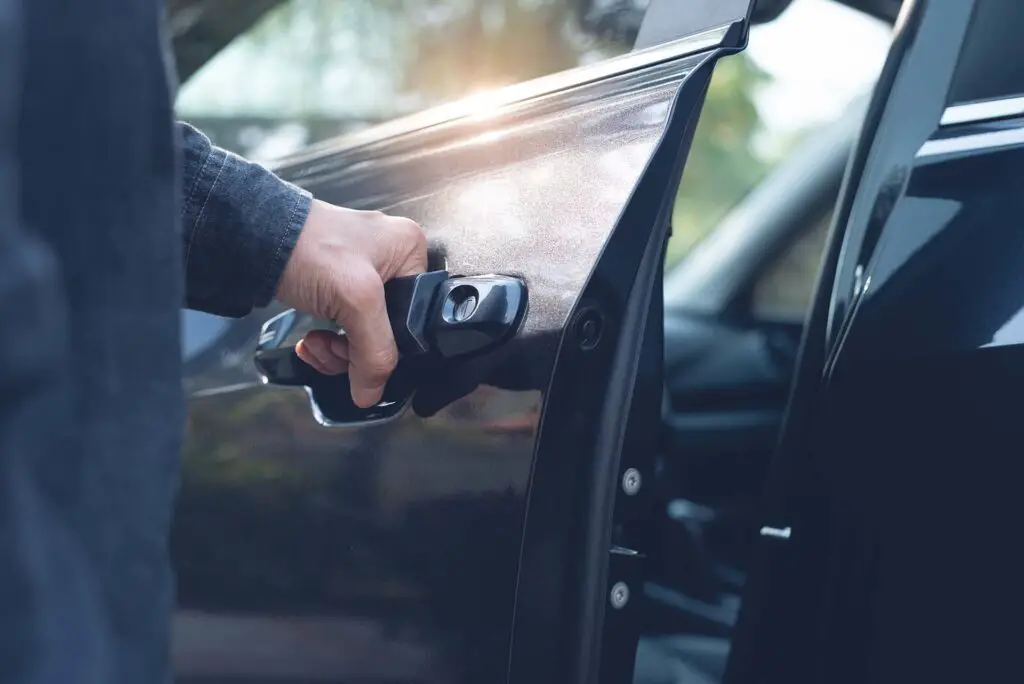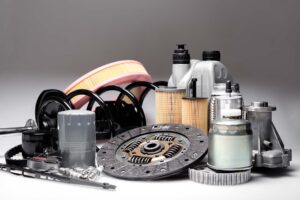Ever noticed those sneaky drafts or leaks in your four-wheeler and wondered how to combat them? If so, today we’re diving deep into the world of car weather stripping repair, unraveling the secrets to keeping your ride cozy and dry. From quick fixes to more extensive repairs, here are the DIY car stripping fixes that’ll help you deal with the problem efficiently.
From removing the damaged seals to cleaning and installing the new stripping, the whole process is pretty straightforward. From then on, maintenance is key to ensuring your vehicle remains comfortable, protected, and efficient in all conditions.
What Is Weather Stripping?
Weatherstripping is an automotive rubber sealant that forms a barrier between your car’s interior and the great outdoors, ensuring that rain, wind, and noise stay where they belong – outside.
Car cabin temperature regulation and leak prevention, as well as noise reduction, are not the only benefits of intact weather stripping. This vital component also helps to protect the structural integrity and longevity of your trusted ride by preventing damage and rust. So, consider vehicle seal maintenance a driver’s responsibility, no matter if you own a brand-new off-road driving four-wheeler or a simple used car.
Most Common Types of Vehicle Weather Strips
Here are the most common types of seals found in modern vehicles when it comes to the materials used in construction:
- EPDM rubber,
- A mix of plastic and rubber,
- A mix of TPO polymer and filler.

Signs Your Weather Stripping Needs Repair
When it comes to vehicle maintenance, this problem is a common one but often flies under the radar. However, the situation can quickly escalate, affecting your driving comfort and the car’s interior health. Therefore, repairing weather seal gaps as soon as possible is crucial for avoiding further damage.
Here are the most common symptoms of damaged weather stripping:
Water Leakage Inside the Car
The most important role of weatherstripping is car interior leak prevention. So, a common telltale sign that something’s wrong is the unwelcome sight of water inside. If you notice pools of water or damp spots on your seats or floor after a heavy downpour or even a light drizzle, protecting the car from water damage is a must.
Increased Road Noise
A peaceful, quiet drive can quickly turn into a noisy ordeal when your vehicle’s seals start to falter. If you begin to hear more road noise, it might indicate an issue with your car’s insulation, and reducing road noise with proper seals is the next necessary step.
Visible Wear, Cracks, or Gap
Common weather stripping deterioration signs are visible wear or cracks in your seals. It might be manifested as hardening, cracks, or even gaps in the seals around the doors or windows, and they call for immediate attention to prevent the issue from escalating further.
Unusual Drafts or Temperature Fluctuations
Feel a draft even with all windows up? Experiencing unexpected temperature swings inside your four-wheeler? These could be the results of compromised seals. It’s not just about comfort – this problem can lead to increased energy consumption as your electric fan or air conditioning works overtime to combat these drafts.
Foggy Windows or Windshield
An unexpected fog build-up on the windows or windshield can be another symptom to look out for. This condensation occurs when seals are unable to effectively keep the outdoor elements at bay, leading to an imbalance in temperature and moisture levels inside the vehicle.
The Impact of Neglected Weather-Stripping
While the telltale signs of compromised seals can often be overlooked, the ramifications extend beyond just a soggy interior. When these seals falter, a cascade of undesirable effects can manifest, impacting not just your driving experience but also your wallet and the car’s overall lifespan.
Here are the negative impacts that further highlight the importance of car seal maintenance:
- Reduced driving comfort – when your experience is characterized by drafts, noise, and temperature fluctuations, it’s definitely not a comfortable ride,
- Increased energy consumption – your car’s Heating, Ventilation, and Air Conditioning (HVAC) system has to work overtime to compensate for the compromised insulation,
- Decreased market value – enhancing vehicle resale value with proper seals can help you sell your four-wheeler as a used vehicle for a higher price when the time comes,
- Increased maintenance costs – as the interior gets exposed to elements like water and excessive heat or cold, the need for repairs and maintenance escalates,
- Safety concerns – compromised seals can lead to foggy windows and windshields, reducing visibility and increasing the risk of accidents.

Tools and Materials Needed for Car Weather Stripping Repair
When it comes to rolling up your sleeves and getting down to business, having the right tools and materials on hand is half the battle won. Here are the essential tools for weather stripping replacement:
| Tool/Material | Purpose |
| Adhesive remover | For cleaning off old adhesive residues from the car’s surface |
| Replacement seals | To replace the damaged or worn-out existing seals |
| Weather stripping adhesive | Used for attaching the new seals securely |
| Seal conditioner | To protect the new seals and ensure their longevity |
| Utility knife or scissors | For cutting and trimming the new seals as needed |
| Screwdriver | For removing any screws or fasteners if necessary |
| Cleaning rags or towels | For cleaning the surface before attaching the new seals |
Here Are a Few Personal Recommendations
If you’re having trouble finding the right door seal replacement, I personally recommend the DOTAATDW Seal Strip, which is made from a durable rubber compound. Moreover, this product is self-adhesive, meaning you won’t have to break a sweat trying to put the adhesive as precisely as possible.
As for keeping the newly installed seal in pristine condition for many drives to come, I recommend the 303 Rubber Seal Protectant. Among all of the seal conditioners for cars I’ve used over the years, this product has proven itself to provide superior protection in extreme temperatures when rubber can quickly dry out and crack.

Step-By-Step Weather Stripping Repair Guide
Luckily, no matter if you need car door weather stripping repair, a quick windshield fix, or trunk seal repair, the process is more or less the same. Master the art of one, and you’ve essentially unlocked the skills to tackle any part of your four-wheeler, restoring that snug, secure atmosphere.
Here’s a step-by-step guide:
Start With Assessment and Removal
First and foremost, it’s time for some window seal troubleshooting. If they’re damaged or worn out, removal is the first order of business. Using a utility knife or a similar tool, carefully extract the old, compromised seals. Be gentle to ensure the surrounding areas, especially the vehicle paint and structure, remain undamaged.
Thoroughly Clean the Area
A clean slate is vital for effective application, so use a quality adhesive remover such as Adam’s Polishes Tire & Rubber Cleaner to get rid of any residuals. Rags or towels can be handy to wipe down the area, guaranteeing a clean, dry surface that’s ready to bond.
Applying Car Sealant or Adhesive
The application of a sealant or adhesive is a critical step. The right technique is to apply it evenly along the surface where the seals will be affixed. Follow the product’s instructions regarding drying to ensure a firm hold.
Installing New Weather Stripping
With the adhesive in place, align the new seals precisely, ensuring they fit snugly and accurately. Use a utility knife or scissors for any necessary trimming. Press firmly to secure the seals in place, ensuring a tight fit that effectively barricades against external elements.
Checking the Repairs
Last but not least, it’s time to inspect the repairs. Carefully go over your handy work and ensure the new seals are securely attached and that doors, windows, and trunks close snugly without any gaps.
Tips for Maintaining Your Car’s Weather-Stripping
Every part of the vehicle, from the engine to the tiniest seal, plays a crucial role in ensuring an optimal driving experience. Therefore, door, window, trunk, and sunroof seal maintenance should not be overlooked.
Here are some tips for prolonging the weather-stripping lifespan:
- Use a mild cleaner and a soft cloth to wipe down the seals, removing dirt and debris that can cause wear over time,
- Applying a specialized conditioner can prevent the seals from drying out and cracking, ensuring flexibility and durability,
- Regularly inspect these parts for any signs of wear or damage, particularly after harsh weather,
- Always ensure that doors, windows, and the sunroof are completely closed to avoid unnecessary pressure or damage to the seals,
- Consider having a professional inspect the seals during your regular car maintenance to catch any potential issues early.

Professional vs. DIY Repairs
Dealing with the problem yourself can be both a rewarding and cost-effective solution, but that doesn’t mean that the DIY weather stripping challenges are easy to overcome. At the end of the day, it’s important to know when it’s time to call in the help of professional weather stripping services.
Navigating through simpler tasks like cleaning and minor repairs can often be done at home. However, the more complex tasks, where the seals are severely damaged, require professional precision and expertise.
Sealing the Deal and Hitting the Road
Now that we’ve ventured into the nitty gritty of this repair, you’re ready to tackle those sneaky leaks and intrusive drafts. Whether you’re a DIY daredevil or someone who appreciates the masterful touch of a pro, knowing your way around these crucial components is a game-changer. So here’s to clear skies, smooth drives, and the sweet silence of a well-sealed ride!
FAQ
Can I Use Household Products to Clean My Car’s Seals?
While it might be tempting to use household cleaners, it’s best to use products specifically designed for automotive use to avoid damaging the material of the seals. Automotive cleaners are formulated to be gentle yet effective on the rubber and other materials common in car seals.
How Often Should I Check and Maintain My Car’s Seals to Ensure They’re in Good Condition?
It’s a good practice to inspect your car’s seals every time you wash your vehicle, or at least once a month. Pay extra attention after extreme weather conditions or if you notice issues like increased road noise or water leakage.
Are There Different Types of Materials Used in Weather Stripping, and Do They Require Different Care?
Yes, seals can be made of various materials like rubber, silicone, or foam, each requiring specific care to maintain their effectiveness and longevity. Always refer to your vehicle’s manual or consult a professional to understand the appropriate care and maintenance routine for the specific materials used in your car’s seals.








